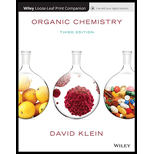
(a)
Interpretation:
The synthetic route for the preparation of given transformation should be determined.
Concept Introduction:
Hydrogenation reaction: The hydrogenation is a reduction reaction which results in an addition of hydrogen. Several organic compounds is hydrogenated, it becomes more saturated.
Linder’s catalyst: The
Soda amide: The
(b)
Interpretation:
The synthetic route for the preparation of given transformation should be determined.
Concept Introduction:
Soda amide: The NaNH2/NH3 is a strong base and excellent nucleophile. Its used deprotonated of weak acids and also for elimination reaction.
Anti- Markovnikov addition: These rules describe the regiochemistry where the substituent is bonded to a less substituted carbon, rather than the more substituted carbon. This placed is quite unusual as carbon cations which are commonly formed during alkene or alkyne reactions tend to favor the more substituted carbon.
(c)
Interpretation:
The synthetic route for the preparation of given transformation should be determined.
Concept Introduction:
Markovnikov addition: The addition reaction of parotic acids to a different alkene or alkyne, the hydrogen atom of
Soda amide: The NaNH2/NH3 is a strong base and excellent nucleophile. Its used deprotonated of weak acids and also for elimination reaction.
(d)
Interpretation:
The synthetic route for the preparation of given transformation should be determined.
Concept Introduction:
Soda amide: The NaNH2/NH3 is a strong base and excellent nucleophile. Its used deprotonated of weak acids and also for elimination reaction.
Metal and ammonia reaction: The alkyne involves sodium (Na)/NH3. This end up reducing to alkyne to give the trans (E) alkene.
Want to see the full answer?
Check out a sample textbook solution
Chapter 9 Solutions
ORGANIC CHEMISTRY-PRINT COMPANION (LL)
- Name the major organic product of the following action of 4-chloro-4-methyl-1-pentanol in neutral pollution 10+ Now the product. The product has a molecular formula f b. In a singly hain, the starting, material again converts into a secule with the molecular kormula CIO. but with comply Draw the major organic structure inhalationarrow_forwardMacmillan Learning Alcohols can be oxidized by chromic acid derivatives. One such reagent is pyridinium chlorochromate, (C,H,NH*)(CICTO3), commonly known as PCC. Draw the proposed (neutral) intermediate and the organic product in the oxidation of 1-butanol by PCC when carried out in an anhydrous solvent such as CH₂C₁₂. PCC Intermediate OH CH2Cl2 Draw the intermediate. Select Draw Templates More с H Cr о Product Draw the product. Erase Select Draw Templates More H о Erasearrow_forwardIf I have 1-bromopropene, to obtain compound A, I have to add NaOH and another compound. Indicate which compound that would be. A C6H5 CH3arrow_forward
- Provide the reagents for the following reactions.arrow_forwardIf I have 1-bromopropene, to obtain compound Z, I have to add two compounds A1 and A2. Indicate which compounds are needed. P(C6H5)3arrow_forwardDraw the major product of this reaction. Ignore inorganic byproducts. Assume that the water side product is continuously removed to drive the reaction toward products. O CH3CH2NH2, TSOH Select to Draw >arrow_forward
 ChemistryChemistryISBN:9781305957404Author:Steven S. Zumdahl, Susan A. Zumdahl, Donald J. DeCostePublisher:Cengage Learning
ChemistryChemistryISBN:9781305957404Author:Steven S. Zumdahl, Susan A. Zumdahl, Donald J. DeCostePublisher:Cengage Learning ChemistryChemistryISBN:9781259911156Author:Raymond Chang Dr., Jason Overby ProfessorPublisher:McGraw-Hill Education
ChemistryChemistryISBN:9781259911156Author:Raymond Chang Dr., Jason Overby ProfessorPublisher:McGraw-Hill Education Principles of Instrumental AnalysisChemistryISBN:9781305577213Author:Douglas A. Skoog, F. James Holler, Stanley R. CrouchPublisher:Cengage Learning
Principles of Instrumental AnalysisChemistryISBN:9781305577213Author:Douglas A. Skoog, F. James Holler, Stanley R. CrouchPublisher:Cengage Learning Organic ChemistryChemistryISBN:9780078021558Author:Janice Gorzynski Smith Dr.Publisher:McGraw-Hill Education
Organic ChemistryChemistryISBN:9780078021558Author:Janice Gorzynski Smith Dr.Publisher:McGraw-Hill Education Chemistry: Principles and ReactionsChemistryISBN:9781305079373Author:William L. Masterton, Cecile N. HurleyPublisher:Cengage Learning
Chemistry: Principles and ReactionsChemistryISBN:9781305079373Author:William L. Masterton, Cecile N. HurleyPublisher:Cengage Learning Elementary Principles of Chemical Processes, Bind...ChemistryISBN:9781118431221Author:Richard M. Felder, Ronald W. Rousseau, Lisa G. BullardPublisher:WILEY
Elementary Principles of Chemical Processes, Bind...ChemistryISBN:9781118431221Author:Richard M. Felder, Ronald W. Rousseau, Lisa G. BullardPublisher:WILEY





